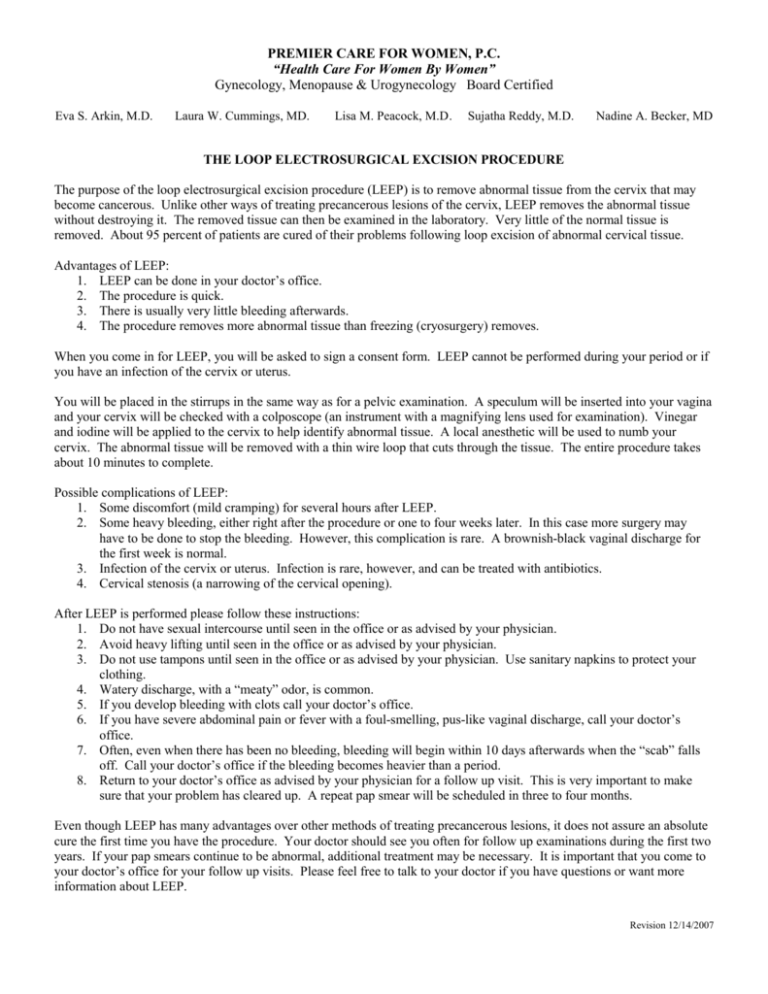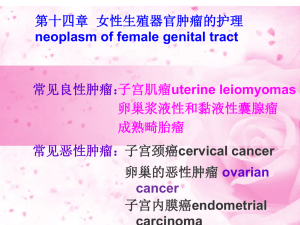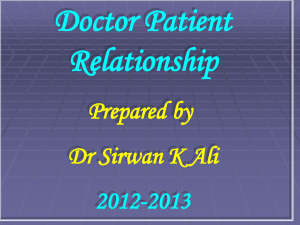
PREMIER CARE FOR WOMEN, P.C.
“Health Care For Women By Women”
Gynecology, Menopause & Urogynecology Board Certified
Eva S. Arkin, M.D.
Laura W. Cummings, MD.
Lisa M. Peacock, M.D.
Sujatha Reddy, M.D.
Nadine A. Becker, MD
THE LOOP ELECTROSURGICAL EXCISION PROCEDURE
The purpose of the loop electrosurgical excision procedure (LEEP) is to remove abnormal tissue from the cervix that may
become cancerous. Unlike other ways of treating precancerous lesions of the cervix, LEEP removes the abnormal tissue
without destroying it. The removed tissue can then be examined in the laboratory. Very little of the normal tissue is
removed. About 95 percent of patients are cured of their problems following loop excision of abnormal cervical tissue.
Advantages of LEEP:
1. LEEP can be done in your doctor’s office.
2. The procedure is quick.
3. There is usually very little bleeding afterwards.
4. The procedure removes more abnormal tissue than freezing (cryosurgery) removes.
When you come in for LEEP, you will be asked to sign a consent form. LEEP cannot be performed during your period or if
you have an infection of the cervix or uterus.
You will be placed in the stirrups in the same way as for a pelvic examination. A speculum will be inserted into your vagina
and your cervix will be checked with a colposcope (an instrument with a magnifying lens used for examination). Vinegar
and iodine will be applied to the cervix to help identify abnormal tissue. A local anesthetic will be used to numb your
cervix. The abnormal tissue will be removed with a thin wire loop that cuts through the tissue. The entire procedure takes
about 10 minutes to complete.
Possible complications of LEEP:
1. Some discomfort (mild cramping) for several hours after LEEP.
2. Some heavy bleeding, either right after the procedure or one to four weeks later. In this case more surgery may
have to be done to stop the bleeding. However, this complication is rare. A brownish-black vaginal discharge for
the first week is normal.
3. Infection of the cervix or uterus. Infection is rare, however, and can be treated with antibiotics.
4. Cervical stenosis (a narrowing of the cervical opening).
After LEEP is performed please follow these instructions:
1. Do not have sexual intercourse until seen in the office or as advised by your physician.
2. Avoid heavy lifting until seen in the office or as advised by your physician.
3. Do not use tampons until seen in the office or as advised by your physician. Use sanitary napkins to protect your
clothing.
4. Watery discharge, with a “meaty” odor, is common.
5. If you develop bleeding with clots call your doctor’s office.
6. If you have severe abdominal pain or fever with a foul-smelling, pus-like vaginal discharge, call your doctor’s
office.
7. Often, even when there has been no bleeding, bleeding will begin within 10 days afterwards when the “scab” falls
off. Call your doctor’s office if the bleeding becomes heavier than a period.
8. Return to your doctor’s office as advised by your physician for a follow up visit. This is very important to make
sure that your problem has cleared up. A repeat pap smear will be scheduled in three to four months.
Even though LEEP has many advantages over other methods of treating precancerous lesions, it does not assure an absolute
cure the first time you have the procedure. Your doctor should see you often for follow up examinations during the first two
years. If your pap smears continue to be abnormal, additional treatment may be necessary. It is important that you come to
your doctor’s office for your follow up visits. Please feel free to talk to your doctor if you have questions or want more
information about LEEP.
Revision 12/14/2007










